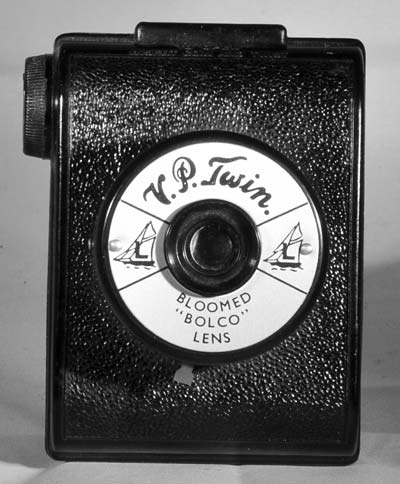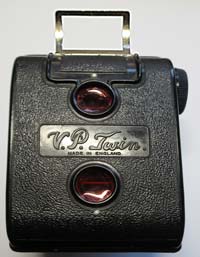E. Elliott V. P. Twin
Specification

| Manufacturer | : | E. Elliott |
|---|---|---|
| Produced | : | 1935 |
| Classification | : | Miniature |
| Body Type | : | Solid Body |
| Construction | : | Bakelite |
| Film Type | : | 127 |
| Film Width | : | 46mm |
| ImageSize | : | 1¼ x 1⅝ |
| No. of Images | : | 16 |
| Lens Type | : | meniscus |
| Focus Type | : | Fixed |
| Focal Length | : | 35mm |
| Focal Range | : | 4ft - inf. |
| Aperture Type | : | Fixed |
| Aperture | : | f/12 |
| Shutter Type | : | Guillotine type |
| Shutter Speeds | : | I*1/200s |
| Size (w x h x d) | : | 90 x 70 x 53 mm |
| Weight | : | 110g |
| * Measured on this camera | ||
Art Deco Credentials
![]()
![]()
Acceptable: Modest and restricted
- Produced during the main Art Deco period.
- Polished Bakelite with impressed leather pattern
- Curvilinear body design
- Chrome pop-up viewfinder

Description
This is a simple Bakelite camera produced in the late 1930 s in a range of colours - black, brown, dark red, dark green, dark blue, bright blue and including marbled blue. The blue finish is rare. It has a chrome frame finder but without an eye piece. This early model has the shutter in front of the lens. Later models have the shutter behind the lens. Production continued after the war and in 1952, a similar model was produced which carried a name plate around the lens and the lens name of Bloomed BOLCO. It had the L-Yacht logo and trademark.

There are ridges on the body behind the viewfinder which are used to prise the back off for film loading. Film advance is by two red windows and is not coupled to the shutter release. The two red windows are used to get 16 exposures from 127 film. The film is advanced until a number appears in the first window and an image is taken. Then the film is advanced until the same number appears in the second window. Then it's back to the first window for the next number.
The shutter only has instantaneous mode and is moved forward and backwards, an exposure for each movement. The camera is fitted with a ground and polished glass lens.
The V. P. Twin is famous for having been sold by Woolworths in three individual parts - the body front, the body back and the shutter/lens assembly. This was because Woolworths' price promise was that nothing cost more than 6d. So they split the camera to sell to their customers within this very limited price range.
The camera was reintroduced in 1952 in black with a metal faceplate and either a white or black wind-on knob.
How to Use
Find the manual for this camera here:- V.P. Twin Manual
This camera takes 127 film which is still available from select outlets - search for 'Rera Pan 100-127' which is a black & white film. For those photographers in the UK, try Nick & Trick photographic services. If you want to use a particular type of film which is not available commercially, then you can cut your own 127 film from any 120 film. See my page on 'How to cut 127 film from 120 film'. Don't forget to cover the red windows except when advancing the film in low light. Modern film is sensitive to red light.
The measured shutter speed on this particular camera was 1/200s on average. When the shutter release was moved in one direction the speed was 1/150s and in the other direction 1/250s. It's always difficult to find out what the speed should be. Some people guess at 1/30s which is obviously way off in this case. As you can see, it's so important to find out the true speed if you want reasonable success in getting the best exposure.
If you don't want to bother with an exposure meter, follow the guide shown. It is based on the 'Sunny 16' rule. Film is so forgiving and will produce acceptable results even when overexposed by 2 or 3 stops or underexposed by 1 stop.
The tables assume that the sun is at least 30 degrees above the horizon - that's 10am - 5pm on a summers day (May - August) in the UK.
Remember that the exposure guide in the manual may not be helpful as it is based on the use of old film with a low ISO value.
If you are not sure about the light level, err on the side of overexposure - i.e. assume the lower light level.
The tables below assume the measured speed of 1/200s. I have shown the performance of the camera for both ISO 100/125 film and ISO 400 film. It looks like ISO 400 film would be the best choice for this particular camera - especially in the UK.
Using ISO 100/125 film - shutter speed 1/200s
| Weather Conditions | Shadow Detail | Aperture | Exposure |
|---|---|---|---|
 Sunny SunnySnow/Sand | Dark with sharp edges | f/12 | +1 Stop Overexposed Acceptable |
 Sunny Sunny | Distinct | f/12 | Good |
 Slight Overcast Slight Overcast | Soft around edges | f/12 | -1 Stop Underexposed Acceptable |
 Overcast Overcast | Barely visible | f/12 | -2 Stops Underexposed Not Acceptable |
 Heavy Overcast Heavy Overcast | None | f/12 | -3 Stops Underexposed Not Acceptable |
 Open Shade Open Shade/Sunset | None | f/12 | -4 Stops Underexposed Not Acceptable |
Using ISO 400 film - shutter speed 1/200s
| Weather Conditions | Shadow Detail | Aperture | Exposure |
|---|---|---|---|
 Sunny SunnySnow/Sand | Dark with sharp edges | f/12 | +3 Stop Overexposed Acceptable |
 Sunny Sunny | Distinct | f/12 | +2 Stop Overexposed Acceptable |
 Slight Overcast Slight Overcast | Soft around edges | f/12 | +1 Stop Overexposed Acceptable |
 Overcast Overcast | Barely visible | f/12 | Good |
 Heavy Overcast Heavy Overcast | None | f/12 | -1 Stops Underexposed Acceptable |
 Open Shade Open Shade/Sunset | None | f/12 | -2 Stops Underexposed Not Acceptable |